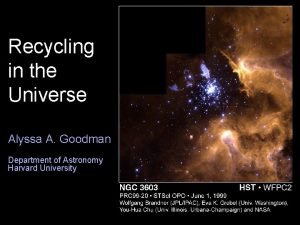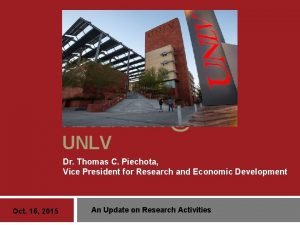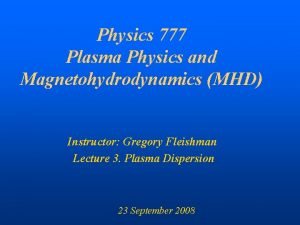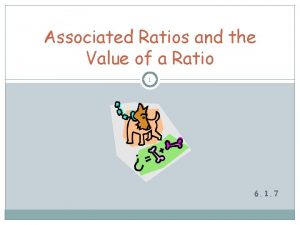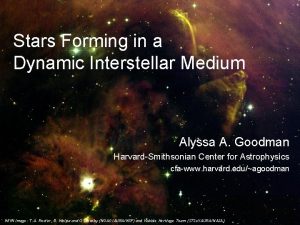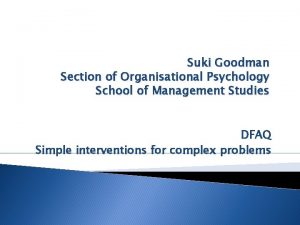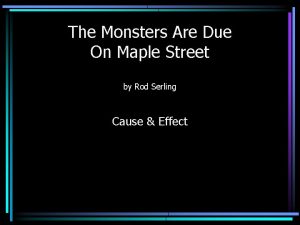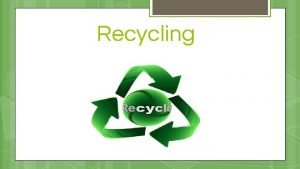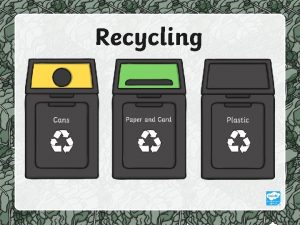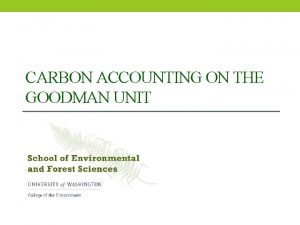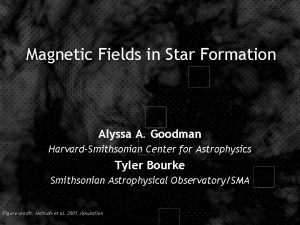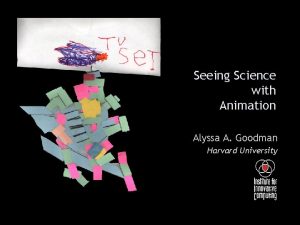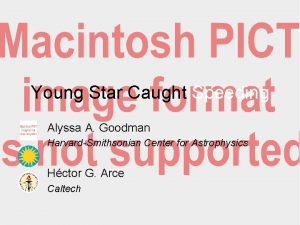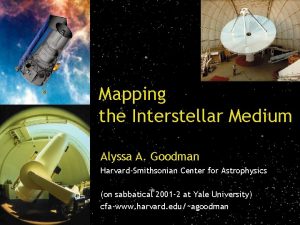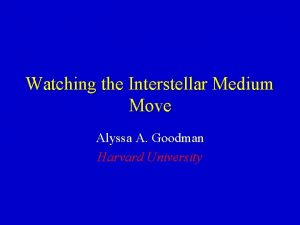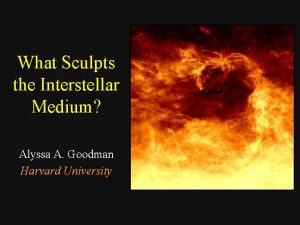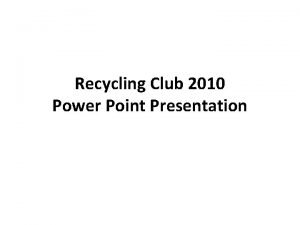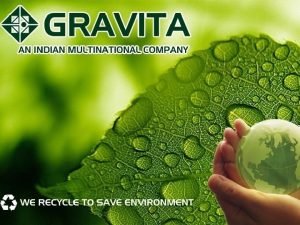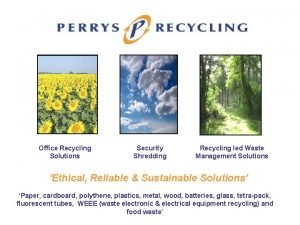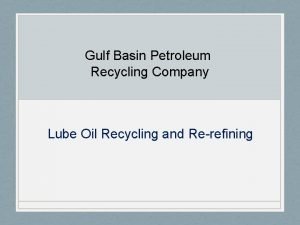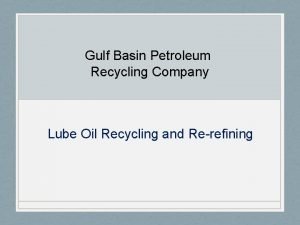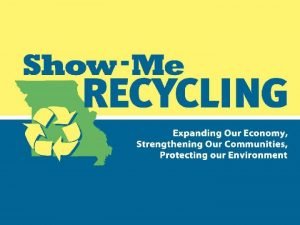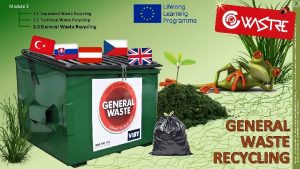Recycling in the Universe Alyssa A Goodman Department



























- Slides: 27

Recycling in the Universe Alyssa A. Goodman Department of Astronomy Harvard University

Recycling on Earth & In Galaxies

Recycling in the Universe

Making the First Recyclables. . . Fluctuations about 300, 000 years after the Big Bang lead to “Structure Formation. ” Gravitational collapse of some of these “structures” produces the first stars and galaxies.

Pretty young galaxies

"Star Formation 101" Molecular Cloud Young Star with Outflow + Protoplanetary Disk Protostellar Core “Main Sequence” Star (with Planets)

Molecular Clouds: The Stuff of New Stars The Oschin telescope, 48 -inch aperture wide-field Schmidt camera at Palomar Red Plate, Digitized Palomar Observatory Sky Survey

How much stuff is there? “Star-counting” Counts of stars per unit area measure how much material must be producing obscuration. Observations by Alves, Lada & Lada 199

Radio Spectral-line Observations of Molecular Clouds

How do Optical & Radio Views Compare? Region of Radio Spectral-Line Survey Observations by Alves, Lada & Lada 199

Cold, Dark & Dusty l l Gas and Dust are Very Cold in Molecular Clouds, T~10=100 Kelvin Dust at 10 K “Glows” in the Far-Infrared

Recycling in the Universe Storage & Collection in Interstellar Medium Discarding Processing, Production Consumption

Consumption of Recyclables The "Initial Mass Function" (IMF) Relative Number of Stars The Hertzprung-Russell Diagram 1 e. g. for every "Sun" there are 22 stars with mass 10 x smaller than the Sun's 6 5 4 3 2 0. 1 6 5 4 3 2 0. 01 0. 1 1 10 100 Mass Relative to the Sun

Stellar Recyclables The Hertzprung-Russell Diagram Supernova, then neutron star/pulsar or black hole Red giant then white dwarf Long-lived brown dwarfs Spectacular contribution, and collection. Explosion injects, and "sweeps up" interstellar material. Good recyclables. Red-giant wind main dust injection in ISM. "Styrofoam"

Stellar Winds: Discarding the Recyclables Mass=100 x Sun

"Excess Gas? " (Post-red-giant planetary nebula)

Stellar Recyclables The Hertzprung-Russell Diagram Supernova, then neutron star/pulsar or black hole Red giant then white dwarf Long-lived brown dwarfs Spectacular contribution, and collection. Explosion injects, and "sweeps up" interstellar material. Good recyclables. Red-giant wind main dust injection in ISM. "Styrofoam"

Massive Stars & Supernovae l l l Winds from O stars account for 30% of recylcable input to ISM Supernovae from O stars throw out much of the remaining mass Biggest contribution of (correlated) supernovae is to “collection”


Swept-up Gas: The Next Generation Far-infrared dust emission map of North Celestial Pole Loop, Pound & Goodman 1997 Spectral-line Emission from Gas In Cassiopeia Tóth et al. 1995

(At least) How much Gas is Swept. Up? ~2 0 p c

Recycling in the Universe Storage & Collection in Interstellar Medium Discarding Processing, Production Consumption

Young Stars do Their Share Too "Cores" and Outflows Giant Molecular Clouds Jets and Disks Solar System Formation


One Picture with the Whole Story Bipolar Wind from Massive Star Cluster of Main. Sequence Stars Molecular Cloud

Recycling in the Universe(? )

For more information. . . cfa-www. harvard. edu/~agoodman and Alyssa Goodman's upcoming article in Sky & Telescope Magazine
 Goodman recycling
Goodman recycling Martha monroy
Martha monroy Alyssa galloway
Alyssa galloway Alyssa pradhan
Alyssa pradhan Alyssa scort
Alyssa scort Alyssa spangler
Alyssa spangler Fisca
Fisca Alyssa gabriel rodriguez
Alyssa gabriel rodriguez Alyssa monks biografia
Alyssa monks biografia Djmfries
Djmfries Alyssa valenti
Alyssa valenti Alyssa ballard
Alyssa ballard Alyssa aherne
Alyssa aherne Mhd alyssa
Mhd alyssa Alyssa hannah
Alyssa hannah The skating party
The skating party Kaying vang
Kaying vang Saul leiter
Saul leiter Alyssa whitcraft
Alyssa whitcraft Alyssa monks biografia
Alyssa monks biografia Alyssa's extended family is staying at the lake house
Alyssa's extended family is staying at the lake house Alyssa rosenberg romeo and juliet
Alyssa rosenberg romeo and juliet Alyssa rxs
Alyssa rxs Keith goodman
Keith goodman Nathaniel hawthorne romanticism
Nathaniel hawthorne romanticism Historical context of young goodman brown
Historical context of young goodman brown Suki goodman
Suki goodman What does charlie accuse goodman of?
What does charlie accuse goodman of?
